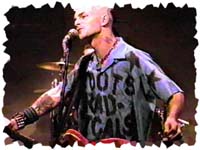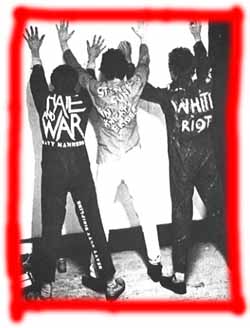|
 This attention to detail, coupled with their sound and production, has led to more than a few comparisons with the Clash. In Spin, the L.A. Times is cited as calling one Rancid performance "Clashmania," and the band soon tires of dealing with questions from Jonathan Gold about this influence, perhaps because it is over-obvious. Armstrong opines that "The Clash were a great band, and I love them dearly . . . but, dude, we've created our own fucking thing." Frederiksen concurs: "There was one historical period when the Clash happened . . . and another where Green Day, Rancid, and the Offspring happened. And the people who think we're just copying the old stuff are the guys driving fuckin' BMWs with anarchy stickers on the bumpers." Spin uses this quote, which seems to suggest a territorial battle over curatorship with the older academics and journalists, as a sidebar teaser in the article, laying it alongside a picture of the top of Frederiksen's mohawked head. This attention to detail, coupled with their sound and production, has led to more than a few comparisons with the Clash. In Spin, the L.A. Times is cited as calling one Rancid performance "Clashmania," and the band soon tires of dealing with questions from Jonathan Gold about this influence, perhaps because it is over-obvious. Armstrong opines that "The Clash were a great band, and I love them dearly . . . but, dude, we've created our own fucking thing." Frederiksen concurs: "There was one historical period when the Clash happened . . . and another where Green Day, Rancid, and the Offspring happened. And the people who think we're just copying the old stuff are the guys driving fuckin' BMWs with anarchy stickers on the bumpers." Spin uses this quote, which seems to suggest a territorial battle over curatorship with the older academics and journalists, as a sidebar teaser in the article, laying it alongside a picture of the top of Frederiksen's mohawked head.

Rancid is one of those bands "made" by MTV. A previous incarnation as punk-ska band Operation Ivy brought little success, but with the Armstrong-directed video for "Salvation" off Let's Go, Rancid became an insider audience and sparked a major-label feeding frenzy. With the video for "Ruby Soho" off the band's next album, And Out Come The Wolves, the band became bona fide stars. As with The Clash, a correlation can be made between the band's success and the nostalgic visual iconography in their videos. "Salvation," filmed in the same style of faux-grainy documentary black-and-white as the London Calling album cover, references punk history sidelong with low shots of punks spraying gravel on the camera with tricked-out Vespa scooters. This actually recalls another recurring British subculture, the Mods, and in doing so historicizes not just punk, but the idea of alternative subculture itself.
 Rancid's next video, "Ruby Soho," largely a simulated live performance, goes further in recalling The Clash. It looks and sounds similar to a Clash performance, particularly the video for "Should I Stay or Should I Go." Much of the correlation between the two bands in the "Ruby Soho" video, though, boils down to the addition of a simple but extremely evocative detail: a shirt. Fronting the band, Tim Armstrong's wears a homemade stenciled top that reads "Roots Radical." A quite interesting textual trail begins at this point; the Clash and the Sex Pistols were famous (and lauded by Marcus and Hebdige) for their customization of store-bought clothes with stenciled slogans, safety pins, and badges. Rancid's next video, "Ruby Soho," largely a simulated live performance, goes further in recalling The Clash. It looks and sounds similar to a Clash performance, particularly the video for "Should I Stay or Should I Go." Much of the correlation between the two bands in the "Ruby Soho" video, though, boils down to the addition of a simple but extremely evocative detail: a shirt. Fronting the band, Tim Armstrong's wears a homemade stenciled top that reads "Roots Radical." A quite interesting textual trail begins at this point; the Clash and the Sex Pistols were famous (and lauded by Marcus and Hebdige) for their customization of store-bought clothes with stenciled slogans, safety pins, and badges.
 According to Marcus and Savage, the Clash's stenciling often quoted from reggae songs, a visual reference meant to augment their affinity with the radicalism of past and contemporary reggae, and another of the band's constant reminders that they had once actually participated with Black Londoners in a race riot. (Their song "White Riot," from The Clash, often misinterpreted as racist, is a plea for a sympathetic "riot of our own.") A famous publicity photo of the band from the late seventies prominently displays some of those slogans: "Under Heavy Manners," "Sten Guns (sic) in Knightsbridge," "Heavy Duty Discipline." One of the most significant custom jobs was Strummer's gig shirt for a New Year's Eve concert that read, simply and boldly, "1977". In addition to merely marking the change of '76 to '77 (and historicizing the present down to the very stroke of midnight), the shirt has Rastafarian meaning: Marcus Garvey had prophesied that Babylon, the system of oppression that keeps the African diaspora from returning to Africa to claim their spiritual birthright, would fall in 1977. It was the year, as the Reggae group Culture sang at the time, that would supposedly see "the two sevens clash." According to Marcus and Savage, the Clash's stenciling often quoted from reggae songs, a visual reference meant to augment their affinity with the radicalism of past and contemporary reggae, and another of the band's constant reminders that they had once actually participated with Black Londoners in a race riot. (Their song "White Riot," from The Clash, often misinterpreted as racist, is a plea for a sympathetic "riot of our own.") A famous publicity photo of the band from the late seventies prominently displays some of those slogans: "Under Heavy Manners," "Sten Guns (sic) in Knightsbridge," "Heavy Duty Discipline." One of the most significant custom jobs was Strummer's gig shirt for a New Year's Eve concert that read, simply and boldly, "1977". In addition to merely marking the change of '76 to '77 (and historicizing the present down to the very stroke of midnight), the shirt has Rastafarian meaning: Marcus Garvey had prophesied that Babylon, the system of oppression that keeps the African diaspora from returning to Africa to claim their spiritual birthright, would fall in 1977. It was the year, as the Reggae group Culture sang at the time, that would supposedly see "the two sevens clash."
 In addition to being an apt description of the general punk sense of curatorship, and nostalgia, Armstrong's "Roots Radicals" stencil is the title of another song on And Out Come the Wolves. "Roots Radicals" is a ska song bursting with delight in punk's affinity with Jamaican music. The chorus reads: "Give 'em the boot, the roots, the radicals / Give 'em the boot, you know I'm a radical / Give 'em the boot, the roots, the reggae on my stereo." In one verse, Armstrong is more specific, dropping the name of a seminal Jamaican ska musician: "The radio was playing, Desmond Dekker was singing / on the 43 bus as we climbed up the hill / Nothin' incoming but the reggae drummin' and we all come from unloving homes / Why even bother, I pick up the bottle, hey mister bus driver please let these people on / Rude-girl Carol was a mini-skirt girl, my blurry vision saw nothing wrong." Contained here is the stereotypical hopelessness of the ignored and troubled suburban teen, Armstrong's own personal historicizing (the Spin article ends with Armstrong proudly showing the interviewer the bus stop from which he escaped his hometown), and a fantasy of love, solidarity, and communal appreciation of music as lifestyle when "these people" including the punker Carol join Armstrong on his escape. In addition to being an apt description of the general punk sense of curatorship, and nostalgia, Armstrong's "Roots Radicals" stencil is the title of another song on And Out Come the Wolves. "Roots Radicals" is a ska song bursting with delight in punk's affinity with Jamaican music. The chorus reads: "Give 'em the boot, the roots, the radicals / Give 'em the boot, you know I'm a radical / Give 'em the boot, the roots, the reggae on my stereo." In one verse, Armstrong is more specific, dropping the name of a seminal Jamaican ska musician: "The radio was playing, Desmond Dekker was singing / on the 43 bus as we climbed up the hill / Nothin' incoming but the reggae drummin' and we all come from unloving homes / Why even bother, I pick up the bottle, hey mister bus driver please let these people on / Rude-girl Carol was a mini-skirt girl, my blurry vision saw nothing wrong." Contained here is the stereotypical hopelessness of the ignored and troubled suburban teen, Armstrong's own personal historicizing (the Spin article ends with Armstrong proudly showing the interviewer the bus stop from which he escaped his hometown), and a fantasy of love, solidarity, and communal appreciation of music as lifestyle when "these people" including the punker Carol join Armstrong on his escape.
Cultural nostalgia can be found in and among many groups, forms, and things. Even, it seems, in a group considered by mainstream culture too young to feel history and too brash to wish for it. Tim Armstrong's cinematic prop, the stenciled gig shirt, holds the same kind of nostalgic weight as the London Calling cover, the longing for any history that promises even the uninitiated viewer a sense of personal relevance and cultural function. Rancid's channeling of the Clash, then, becomes emblematic of a willingness to accept the weight thrust on punk's shoulders from within and without, and to demystify its symbolic complexity in service of the genre. The video for "Ruby Soho" is a propagation of punk, a wresting of a personal meaning system away from the seemingly oppressive culture in which, the band implies, hypocrisy runs rampant, corporate capitalism encroaches, and BMW-driving posers claim radicalism as their own. In opposition to this is an act of curatorship that pares down punk iconography to a "pure" form where all punk images of the present lead only to their own nostalgic history.
Greg Wahl is a Ph.D. student at the University of Maryland College Park. His record collection attempts to reconstruct those of his friends' big brothers.
page 2 of 2

Go to sources.
|






